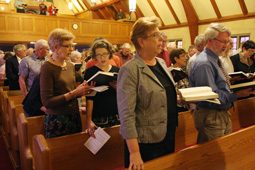A starter's guide to choosing hymns
- Worship Resources:
- Making the most of hymns
 Why do we sing hymns?
Why do we sing hymns?
For many unfamiliar with church worship, the exercise of standing to sing words to a repeated tune may feel a little odd. So why do we do it?
As well as exemplifying the "work of the people" (“liturgy”) in worship, the singing of hymns is also the way in which, for many people, basic theology takes root.
Augustine of Hippo is said to have observed that “whoever sings [to God in worship], prays twice”. In other words, as hymn writer Brian Wren puts it, “when we sing a praise and prayer instead of simply speaking it, we add something important to the utterance”. He adds that the words we sing deserve our attention because “they either enlarge and develop Christian faith, or distort and diminish it”. (Praying Twice, 2000 p.1)
Why use hymn books?
Hymn books published by a church denomination are designed to reflect its full range of Christian understanding. They also reflect the seasons and celebrations of the Church year; and our diverse human and Christian experiences.
As the lectionary does for the Bible, a hymn book has the potential to help us express our “whole story”. Which hymn books do we use?
Which hymn books do we use?
There is a world of hymn books and resources to choose
from for worship. (Wikipedia provides an exhausting – but undoubtedly not exhaustive – list of English language hymnals by denomination.)
In order to offer some continuity, shared experience, and the security that comes with repetition, the Methodist Church has designated certain “authorised” hymn books, the most recent of which is Singing the Faith.
That said, Methodist congregations are often open to learning new hymns and songs from other sources (including our own StF+ New Hymns). It can be worth taking the time to become familiar with new tunes/words before using them – perhaps by learning them before the service begins, or by asking one your organist/pianist to play them over in full before singing.
We should remember, too, that many of our church members are familiar with – and have loved – other music styles and publications, and be responsive to their needs.
How do the indices help?
Most hymn books have a range of indices to help us choose the most appropriate hymns for our worship theme or to reflect the subject matter of the readings. They can –
- help us get to know a hymn book better, revealing less well-known hymns
- ensure that we reflect the full story of our worship e.g. reflecting the different characteristics of God; the different elements of a worship service (praise, confession, “going out” etc.)
- create a variety of singing opportunities in our worship by offering a range of styles/lengths of hymns – singing five big hymns like “And can it be” can be exhausting!
 NB. The full range of indices is usually only available in the full music edition of the book. For example, Singing the Faith includes the following indices:
NB. The full range of indices is usually only available in the full music edition of the book. For example, Singing the Faith includes the following indices:
Index of Biblical Texts – lists hymns that in some way reflect a Bible verse or passage. This is a great starting place for choosing hymns, but a little care needs to be taken, as often the index refers to a single verse of a hymn – is the rest of the hymn as appropriate as you would like?
Liturgical Index – links directly to Christian seasons but also specific Sundays e.g. Mothering Sunday, Bible Sunday
Items particularly suitable for children and all-age worship
Alphabetical index of tunes
Metrical index of tunes – the vast majority of hymns in CH4 have regular metres i.e. each verse uses the same structure of syllables per line. A regular metre will also ensure that the weight of those syllables falls in the same place in each equivalent line.
This means that texts with the same metre can often be paired with different tunes of the same metre; which is useful if you really want certain words but the tune is unfamiliar, or if you feel the mood of one tune is more appropriate than another for your purposes. This isn’t a hard and fast rule, so if you’re unsure, check with the organist/pianist for your service. For more information about metres see Ian Worsfold’s Metre in Hymnody – the basics!
Composers / Arrangers
Authors / Translators
First lines and tunes
Addresses of major copyright owners